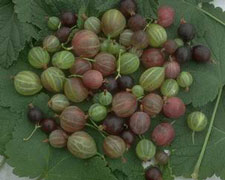


Home
Flowers &
Indoor Plants
Fruits & Nuts
Ornamentals
Vegetables
Special Topics
Resources
Glossary

Gooseberry |
 |
What about it? The gooseberry is a close relative of the currant, and its culture is very similar. There are white, green, yellow and red-fruited varieties; most are slightly smaller or about the same size as a table grape. Although gooseberries are not popular in this country, they have some very nice characteristics! In addition to being a tasty, easy-to-grow fruit, gooseberries can be an effective barrier plant (nobody would walk through those thorns!) and are one of the few fruits that tolerate shade. They grow to 3-5 feet and have small, attractive, palmate leaves. What is it used for? Gooseberries are delicious fresh, and can be very sweet if allowed to remain on the cane until they are ripe. The gooseberry is probably best known for its use in pies, preserves, jams, jellies and tarts. Where does it grow? How do we grow it? Gooseberries are very hardy and can be grown in areas having cold winter temperatures. They tolerate shade, but perform well in full sun. Gooseberries prefer a loamy soil, but do well under a broad range of soil types. They require good drainage, and perform best if pruned lightly each year. What are its primary problems? Common diseases of gooseberries include anthracnose, rust, powdery mildew, leaf spot, and canker. Common insects include the San Jose scale, currant borer, currant maggot, and flat-headed borer. European gooseberries are highly susceptible to American powdery mildew. How do we harvest and store it? Gooseberry harvest is labor-intensive, because the berries must be harvested one at a time to avoid the thorns. It helps to wear gloves and a long-sleeved shirt. Gooseberries will keep for short periods at cool temperatures.
© Copyright, Department of Horticulture, Cornell University. |



